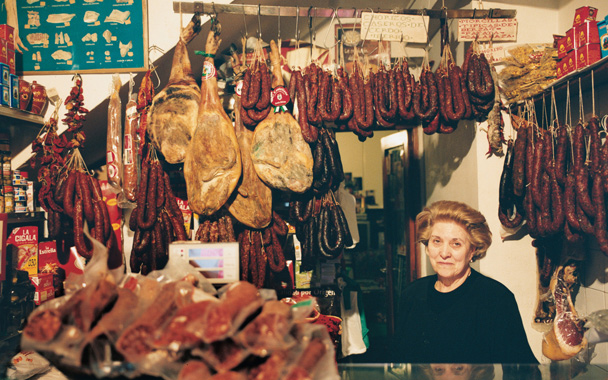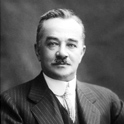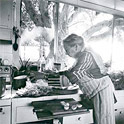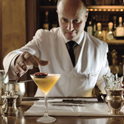This is what you do. You wait until well past nightfall, maybe midnight, maybe later. You climb up the steep path that leads to the old city, the path that runs beneath archways carved into ancient walls. There, the yellow light of the street lamps reflects off the granite palaces and convents built centuries ago. The only noise you hear is that of your heels reverberating on stone. You are alone up there, and you feel it: the beauty of the night, the weight of the past, love, solitude, longing—all the things poets write about. And then you walk back down, into the Plaza Mayor, where the tapas bars are closing and the teenagers are making out on the benches, and you are back in the lively heart of Cáceres, back in the Spain you know.
Toño Pérez pressed the walk upon me as if it were a final course to my meal, one more taste after the crisp disk of pig face and the tangy dollop of ice cream made with the region’s legendary Torta del Casar. By now I had become accustomed to his ebullience, a radiant enthusiasm belying the modest ambition you might expect from a chef cooking in the provincial town where he grew up. But this was different. He wanted me to understand something about him, about where he came from, and in so doing to understand something about the austere, earthbound place that is Extremadura.
Extrema: extreme; dura: hard. In truth, the region’s name (it depends on who you ask) is derived from either its position on the south side of the Duero River or its reconquista-era location at the edge of the kingdom of Castile. But it is my homemade, and quite literal, translation that I like best; few geographical names in Spain are as descriptive. Running west from Castilla-La Mancha toward the Portuguese border, the region is harsh and often barren, its sun-baked plains mostly given over to the herding of sheep and goats. It is the poorest area of the country and couldn’t be farther, metaphorically, from the Spain of so much recent celebration, the Spain where well-dressed locals press noisily against San Sebastián’s pintxo bars and models troll Barcelona’s Boqueria market with cellphones pressed to their ears. “Extremadura isn’t like the rest of Spain,” says Pérez. “Poverty brought hardships, but being poor kept us authentic.”
It has been this way for centuries. In the 1500s, Spain’s best conquistadors—those lesser nobles and ragged soldiers who would, in the name of God and country, gallantly despoil much of the Americas and call their depredations “discovery”—came from Extremadura, taking on the adventure of conquest mainly because there was nothing for them at home. So many conquistadors came from the single town of Trujillo, they say, that 20 American countries were born there. Francisco Pizarro was one of them; in search of opportunities in the New World, he left behind a miserable life as a swineherd and went on to conquer what is now Peru. He returned with treasures that would help transform his rustic outpost of a hometown into a Baroque jewel. Gold and silver plundered from the Incas helped underwrite the elegant palaces (one of them owned by Pizarro’s descendants) that line the city’s broad, magnificent Plaza Mayor; the altars of Trujillo’s churches still glitter as if new. Yet the Spaniards were never all that good at converting American treasure into durable wealth, and by the 18th century Trujillo had slipped back into decline. Today, just enough gentle neglect settles over the square to make the city’s fall from grace feel poignant.
Climbing the tiled staircase to Restaurante Pizarro is like stepping back into an earlier era of dining, complete with stiff-backed chairs at the tables and uninspired oil paintings on the walls. Manuela Carrasco, 76, and her sister Isabel, 75, inherited the restaurant from their parents (it was founded in 1919) and have worked there since they were teenagers, each doing what she loves best—Manuela in the kitchen, Isabel out front. On the day I visit, Isabel is recovering from knee surgery in her apartment downstairs, but Manuela is tottering around in sturdy shoes, taking care of her guests and overseeing the cooking. “We haven’t changed anything,” she says proudly, then catches herself. “There is that one potato dish Isabel makes. But otherwise, no, we don’t innovate at all.”
A quick scan of Pizarro’s menu offers a summary tour of Extremadura’s culinary landscape. “There’s a lot of meat,” says Manuela, with characteristic understatement. Lamb, goat, and pork figure prominently—each roasted with thyme or fried with its liver and slowly braised for frite. The few vegetables listed tend toward the thorny and rugged—wild asparagus, baby cardoons. A tomato soup grabs my attention. Instead of a common gazpacho, this soup is hot, made with nothing more than tomatoes, oil, and bread. It’s served with a bowl of grapes, which the waiter sets down with instructions “to float them like croutons.” It strikes me that in its simplicity—its pure tomato-ness, with hints of smoked paprika and cumin—this soup is as much a paean to history as the statue of Pizarro outside. Gold and silver, after all, weren’t the only treasures the conquistadors brought from the New World; they also carried back potatoes, peppers, and tomatoes.
Manuela calls their kind of cooking “folk” food, but she also reminds me of another element in the region’s culinary history: the monastery. Extremadura’s conquistadors didn’t travel alone; with them went monks, who saw in the Americas a new world of souls to convert. They returned bearing edible marvels, but with an advantage: Monks knew how to cook. It was through their networks that those potatoes and peppers and tomatoes spread throughout Spain and then to the rest of Europe.
The monastery of Santa María de Guadalupe, in fact, was once the El Bulli of its day, a place where the latest trends in global gas tronomy were developed and disseminated. Today, it is a jumble of dramatic towers and ornate sanctuaries that jut imposingly over the town’s whitewashed houses and green hills. Franciscans—some in rough brown habits, others in jeans—have replaced the original Hieronymites, but the monastery remains a favored pilgrimage site for the faithful, who come to pray before the statue of a dark Virgin.




 Pinterest
Pinterest






